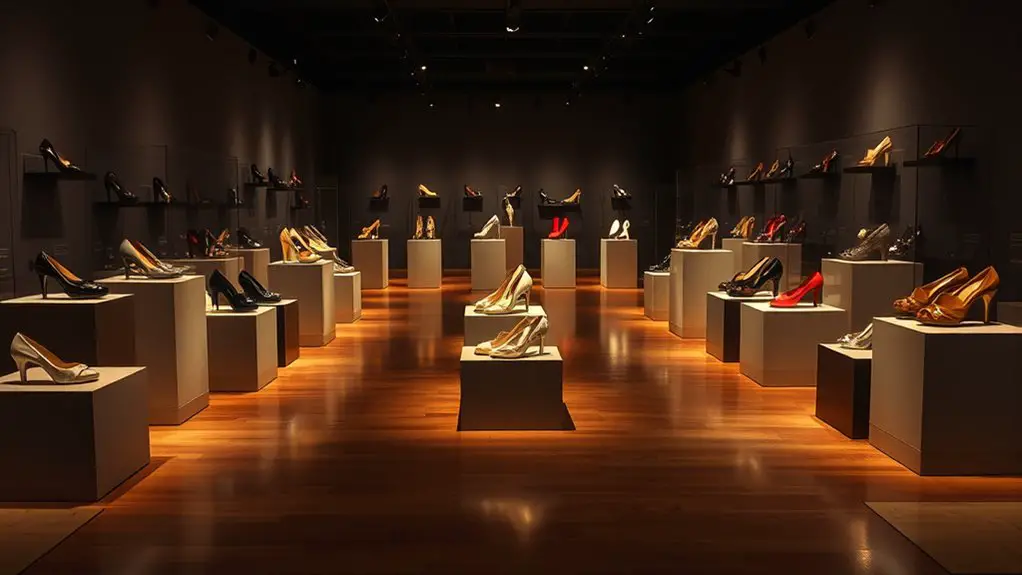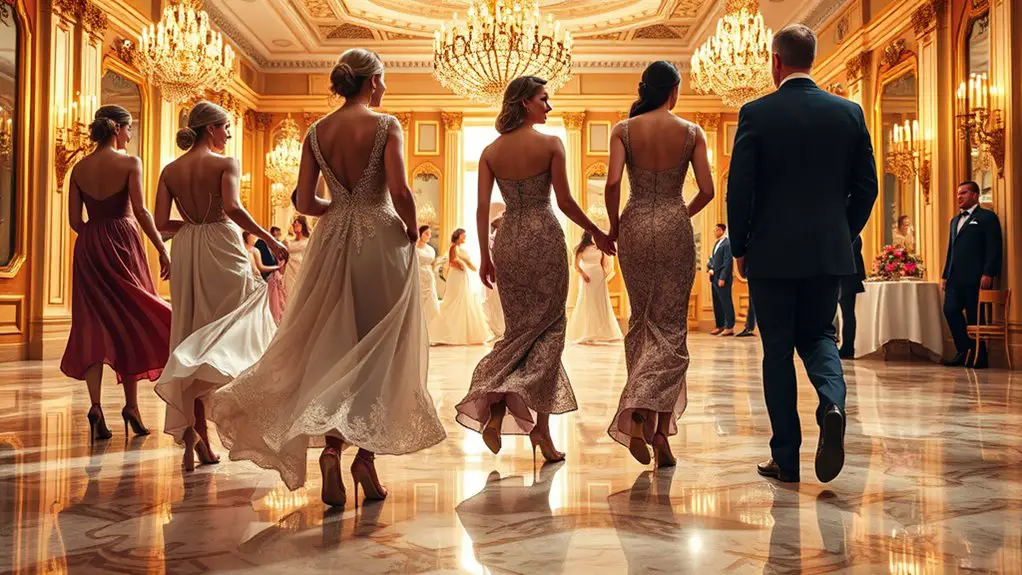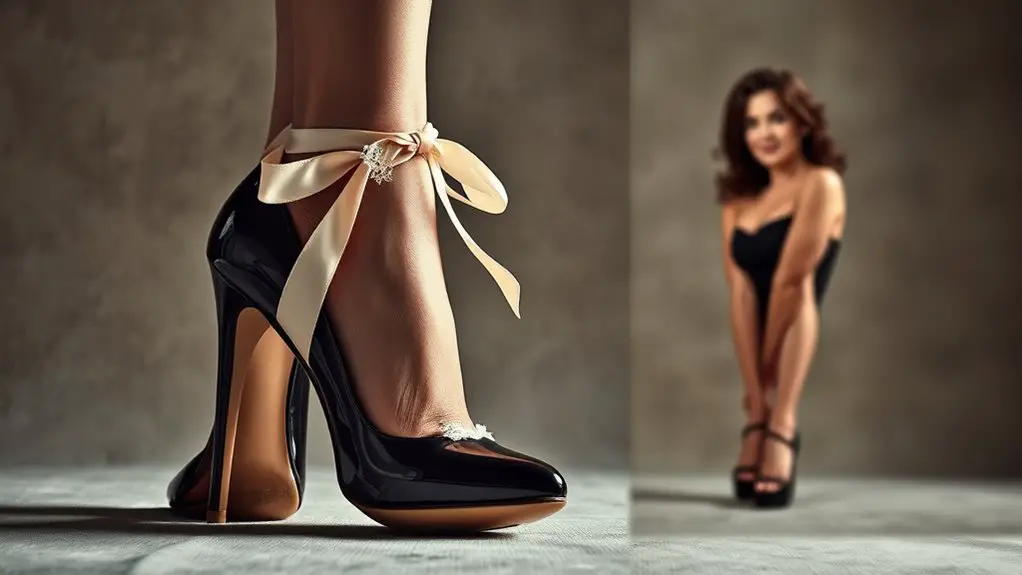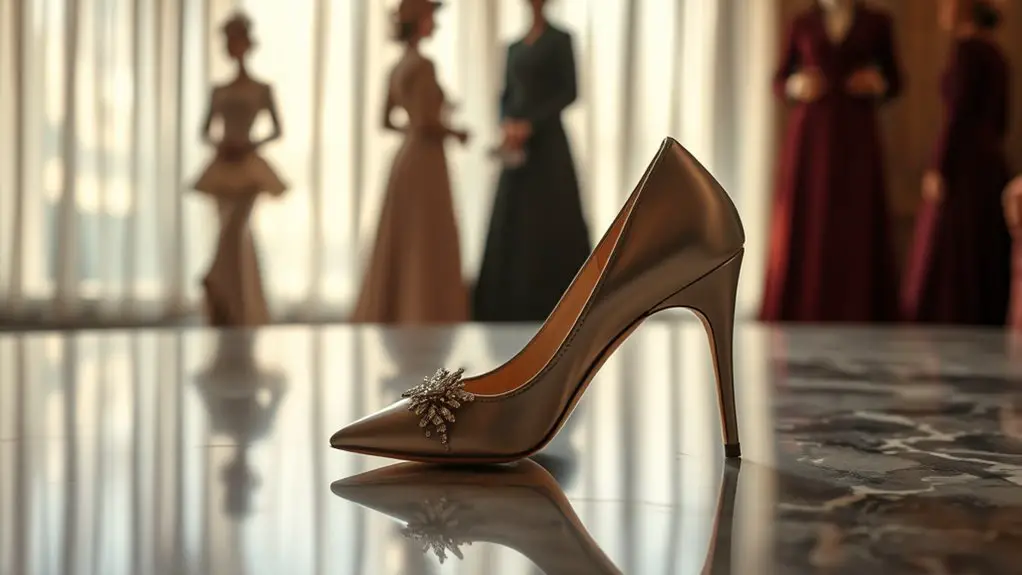Women started wearing high heels as a blend of functionality and social status, originally seen in ancient civilizations. High heels denoted power and rank, shifting from practical uses in Persian cavalry to symbols of femininity within European aristocracy. As societal norms evolved, high heels became tools for self-expression and empowerment, yet they also reflect historical expectations of women. Understanding their journey reveals deeper insights into fashion’s role in shaping identity and societal dynamics.
The Origins of High Heels: A Historical Perspective

High heels, often seen as a symbol of elegance and femininity, have a fascinating history that dates back to ancient civilizations. Originally, ancient footwear was designed for practicality, but they evolved into status symbols. In ancient Egypt, for instance, both men and women wore elevated shoes to denote social rank, while in Greece, heels were used in theatrical performances to signify character importance.
Their cultural significance extends beyond mere aesthetics; high heels have historically represented power and authority. The elevation created by heels not only enhances stature but also alters posture, projecting confidence. This shift from functional footwear to fashionable statement reflects societal values and gender norms throughout history. As you explore the origins of high heels, you’ll see how they’ve transcended their practical beginnings to become a multifaceted symbol of identity, status, and cultural expression.
High Heels in the Persian Cavalry
The evolution of high heels took an intriguing turn in the realm of the Persian cavalry, where they served a practical purpose beyond mere aesthetics. In this military setting, high heels weren’t just fashion statements; they provided essential benefits. The elevated heel helped cavalry soldiers maintain stability in the saddle, offering a better grip and reducing the risk of slipping. This design allowed for more effective maneuverability during combat, showcasing a fascinating intersection of military practicality and style.
Moreover, these heels symbolized power and authority, distinguishing Persian cavalry from other forces. The visual height conferred an imposing presence, which could intimidate opponents. Consequently, in this scenario, high heels transcended their ornamental value, becoming a functional aspect of warfare. By understanding this origin, you can appreciate how high heels evolved from utility in the Persian cavalry to their later cultural significance in fashion and society.
Adoption by European Aristocracy

As high heels shifted from their practical origins in the Persian cavalry, they found a new life within the European aristocracy during the late Renaissance. In this setting, high heels became a vital element of aristocratic fashion, symbolizing both wealth and power. You’d notice that noble women embraced heels not just for their height, but as a statement of social status. The higher the heel, the more pronounced the distinction between the elite and the commoners.
Aristocrats often adorned their shoes with luxurious materials and intricate designs, making them a canvas for artistry that reflected their elevated position. As a result, wearing high heels transformed into a ritual of showcasing affluence and sophistication. This adoption wasn’t merely about aesthetics; it was a calculated move to reinforce social hierarchies, where every inch of elevation mattered in signaling one’s place within the rigid social structure of the time.
The Role of High Heels in Gender Identity
High heels have long served as a powerful symbol of gender identity, reflecting historical norms and expectations surrounding femininity. When you consider how these shoes have evolved, it’s clear they can also represent empowerment, allowing women to assert their presence in various social and professional arenas. This complex relationship between high heels and gender identity invites a closer look at how fashion can shape and challenge societal perceptions.
Historical Gender Symbolism
While many may see high heels as mere fashion statements, their historical significance is deeply intertwined with gender identity and societal expectations. High heels have long served as cultural symbolism, shaping and reinforcing gender roles. You might notice:
- Feminine Ideal: High heels elevate physical stature, aligning with traditional notions of femininity.
- Power Dynamics: Historically, they were worn by both genders, but over time became a marker of women’s subservience in patriarchal societies.
- Social Status: Wearing heels often indicates wealth and exclusivity, further perpetuating class distinctions.
- Sexualization: High heels have been used to emphasize sexuality, influencing societal perceptions of women.
Understanding these elements highlights how high heels reflect and challenge historical gender norms, revealing a complex relationship between fashion and identity.
Empowerment Through Fashion
Empowerment often manifests through personal expression, and for many women, high heels serve as a powerful tool in maneuvering their gender identity. High heels not only enhance physical stature but also embody a form of feminine expression that transcends mere aesthetics. They allow women to assert their presence and redefine conventional notions of femininity. In a world where fashion autonomy is often limited, high heels offer a way to reclaim control over personal style, signaling confidence and strength. By choosing to wear them, women challenge traditional gender roles, showcasing that femininity can coexist with power. Within this framework, high heels become more than just footwear; they symbolize a deliberate choice to navigate and embrace one’s identity on personal terms.
High Heels and the Evolution of Femininity

As society’s standards of femininity have shifted over time, so too has the significance of high heels in women’s fashion. Initially embraced for their ability to enhance feminine allure, high heels have become a complex symbol influenced by cultural perceptions. Here are four ways high heels reflect the evolution of femininity:
- Historical Symbolism: High heels once indicated social status, emphasizing women’s roles in the aristocracy.
- Feminine Empowerment: In modern contexts, they serve as a tool for self-expression and confidence, challenging traditional norms.
- Cultural Divergence: Different cultures interpret high heels variably, from symbols of liberation to instruments of objectification.
- Fashion Versatility: High heels adapt to contemporary trends, showcasing how femininity evolves while maintaining allure.
Ultimately, high heels encapsulate a dynamic interplay between societal expectations and individual identity, marking the continual evolution of what it means to be feminine.
Societal Influences on High Heel Fashion
The evolution of femininity through high heels is closely intertwined with societal influences that shape fashion trends. Your perception of high heels is often molded by the cultural context you live in. Over time, societal perceptions have elevated high heels from mere footwear to symbols of style and desirability.
| Era | Influence on High Heels |
|---|---|
| 17th Century | Associated with aristocracy and status |
| 20th Century | Popularized by celebrities and media |
| 21st Century | Embraced for empowerment and fashion |
| Modern Trends | Diverse styles reflecting individualism |
These influences contribute to how you view high heels today. As fashion trends evolve, they reflect broader societal norms, encouraging you to embrace or reject certain styles based on collective attitudes. Understanding these influences allows you to appreciate the deeper significance behind your choice to wear high heels.
High Heels as a Symbol of Power and Status
High heels have long served as a potent symbol of power and status, tracing their roots back to aristocratic fashion in the 16th century. As you look at fashion icons who embraced this trend, it’s clear how heels have evolved to represent authority and confidence in various professional settings. The dynamics of power in fashion often hinge on how these elevated shoes communicate social standing and ambition.
Historical Origins of Heels
While many associate high heels with contemporary fashion trends, their origins reveal a complex narrative interwoven with power and status. High heels date back to ancient footwear, often linked to social hierarchies and authority. They weren’t just about aesthetics; they held cultural significance.
- Ancient Egypt: Both men and women wore elevated shoes to signify wealth and status.
- Persian Cavalry: Heels were practical for horseback riding, later adopted as symbols of dominance.
- Renaissance Europe: Nobility embraced heels to elevate their social standing, literally and figuratively.
- Fashion Evolution: Over time, heels shifted to women’s fashion, continuing the legacy of power and prestige.
These historical roots illuminate how high heels became enduring symbols of status, reflecting the complexities of societal values.
Influence of Fashion Icons
As influential figures in fashion have emerged throughout history, high heels have increasingly become synonymous with power and status. Fashion icons like Audrey Hepburn and more recently, Beyoncé, have wielded their celebrity influence to elevate high heels beyond mere footwear. You see, when these icons step out in towering stilettos, they don’t just showcase a trend; they embody confidence and assertiveness. The visual impact of high heels often aligns with the personas these stars cultivate, reinforcing the idea that power can be both stylish and commanding. As you navigate the world, consider how these fashion icons have shaped perceptions of femininity and authority, making high heels a cultural emblem of empowerment and aspiration.
Power Dynamics in Fashion
The relationship between high heels and power dynamics in fashion reveals how footwear can transcend mere aesthetics to become a potent symbol of authority. High heels often serve as a vehicle for feminine expression and status symbols, reflecting societal hierarchies.
Here are key elements that illustrate this connection:
- Cultural Significance: High heels have evolved from a male-dominated accessory to a feminine staple, embodying power.
- Professional Settings: In corporate environments, heels can signal ambition and confidence, enhancing perceived authority.
- Social Events: At high-profile gatherings, heels often denote status, distinguishing wearers from others.
- Fashion Trends: Designers leverage heels to reinforce power dynamics, making them integral to luxury branding.
Ultimately, high heels continue to shape and redefine notions of power in contemporary fashion.
Modern Interpretations and Cultural Significance
Although high heels have long been associated with femininity and elegance, their modern interpretations reveal a complex interplay of empowerment, rebellion, and societal expectations. Today, many women use high heels as a form of gender expression, embracing them as symbols of personal identity and confidence. However, this choice can also spark discussions about cultural appropriation, especially when styles are borrowed from different cultures without context or respect.
In many settings, high heels serve as a statement against traditional gender norms, allowing wearers to assert their individuality. Yet, societal pressures can often complicate this empowerment, as the expectation to wear heels can feel more like a requirement than a choice. Therefore, while high heels can embody freedom and self-expression, they also reflect ongoing tensions within fashion—where personal autonomy meets collective cultural narratives. Understanding these dynamics helps you navigate the multifaceted significance of high heels in contemporary society.
Frequently Asked Questions
How Do High Heels Impact Women’s Health Over Time?
“Beauty’s pain” often rings true for you, as high heels can severely impact foot health. Over time, they may lead to joint issues, nerve damage, and other long-term effects, compromising your overall well-being and mobility.
What Are the Most Common Misconceptions About High Heels?
You might think high heels are solely about fashion, but cultural perceptions often fuel myths, like their necessity for elegance or professionalism. In reality, comfort and health should also be prioritized over outdated ideals.
How Do High Heels Affect Posture and Gait?
High heels greatly impact your posture alignment and gait mechanics. They elevate your heels, shifting your center of gravity, which can lead to an unnatural spinal curve and altered walking patterns, often causing discomfort and long-term issues.
Are There Specific Occasions When High Heels Are Considered Inappropriate?
Like a fine wine, high heels can elevate your style, but in certain social settings, they can clash. In the workplace, practicality often trumps flair, making heels inappropriate for formal meetings or labor-intensive tasks.
How Have High Heels Influenced Men’s Fashion Trends Historically?
High heels historically influenced men’s fashion by challenging masculine aesthetics and redefining gender roles. They prompted men to adopt elevated footwear, reflecting status and power, thereby reshaping perceptions of masculinity and style throughout various eras.



